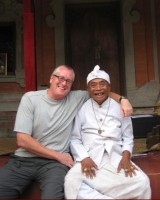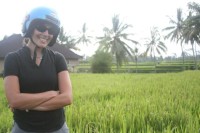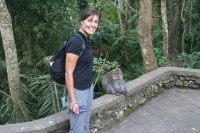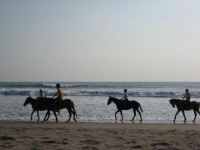As I mentioned in an earlier post, I read Elizabeth Gilbert’s “Eat, Pray, Love” at the beginning of our trip. For those of you who haven’t read the book, it tells of the author’s year of travels through Italy, India and Bali. Like us, she spent most of her time in Bali in the city of Ubud, where she befriended both a traditional Balinese healer named Wayan and an old medicine man named Ketut Liyer. Both Wayan and Ketut seemed to me to be of a Bali from long ago–one that I very much wanted to learn more about. I arrived in Ubud determined to track down both of them and was happy to see that Ms. Gilbert had made the task significantly easier by posting their addresses on her website.
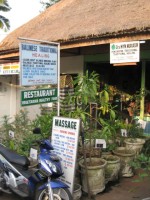
Happily, Wayan’s shop was walking distance from our hotel. We dropped by on Saturday afternoon and, within a few minutes, we were sitting with her at her shop’s only table drinking tumeric juice with honey (“for strength,” she said). As a sort of preview of her services, she gave us a quick once-over and then listed a few of the things that ailed us. I should have been suspicious when, after looking at Derek’s fingernails, she pronounced that he needed to eat fewer sweet things (the man loves food more than anyone I know, but he’s definitely not a dessert eater), but I was breathlessly excited to have met the woman who, in the book, had cured an infection normally remedied by a week’s worth of antibiotics using only some herbal compresses. I made an appointment to meet with her for two hours on Monday. Derek, who was more skeptical, particularly when he heard the price (more than double what the other “healing shops” charged), passed.
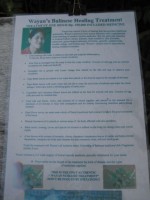
When Monday morning came around, I arrived in Wayan’s tiny shop expecting to be amazed at her abilities and newly convinced of the healing powers of herbal remedies. When I left three and one-half hours later, I had received only a sobering illustration of the destructive powers of the popularity that came to her after the book’s publication. (I’m sure the same fate has befallen countless vendors who find themselves listed in the Lonely Planet or other guidebooks and, therefore, on most Westerners’ short list of acceptable places to frequent).
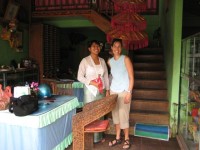
For fifteen minutes, Wayan provided me with a list of my ailments that was quite similar to the one she had given me two days before. It reminded me of a horoscope, in that it was vague enough to avoid being inaccurate (“you sometimes have a busy mind”) and general enough to apply to just about anyone (“you need to drink more water”). She supplied me with a bag full of pills, potions and powders, one of which promised to address everything from diabetes to “new and old paralyzed” to “finishing the nasty smell of mouth and nose,” as well as a schedule of when to take what. She then directed me to go upstairs.
Wayan had explained earlier that the book’s popularity had caused her business to boom and had necessitated the hiring of two assistants, a woman who looked to be about 18 and a man in his 20s. These two met me upstairs and proceeded to rub me with betel leaves, rice mixed with galangal root, aloe vera and, at one point, pieces of a cucumber. The treatments weren’t accompanied by any explanation. While I found myself wondering both whether Wayan was coming back (I’d understood my appointment to be with HER) and why someone was rubbing cucumber in my eye, the experience was not altogether unpleasant.
The assistants then directed me to lie face-down on a massage table. (What? Language barriers prevented me from pressing them for more information. I definitely had not signed up for a massage, but ok….) I did as instructed, and then things got confusing. I was left alone with the male assistant, who, in a nutshell, began acting inappropiately. (Don’t worry, Mom, nothing criminal or even very serious happened.) I left Wayan’s shop as soon as I could and hurried back to the hotel with the events of the morning replaying in my mind. Â
After reflecting more fully on the experience, I returned to Wayan’s shop a few hours later with Derek in tow and confronted Wayan about what had happened. To her credit, Wayan appeared to be both appalled and surprised at her employee’s behavior. What she said by way of an explanation gave me an important insight into both the depths of her beliefs and the corrupting powers of the fame that had come to her. According to her, the man’s actions had been caused by evil spirits born of the jealousy of other Balinese people over her good fortune. Her popularity meant that she had too many clients to handle so, when she saw me that morning, she had been too drained to provide any healing and had instead needed to relegate me to her assistants. She was sorry; she would deal with her assistant; she was so, so sorry. Both Derek and I noticed, incidentally, that she never offered to refund my money. I had come to her shop in search of an “authentic, Balinese experience” (perhaps this fact alone reveals my naivete). I left disillusioned.Â
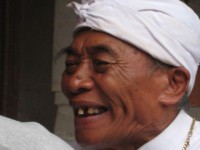
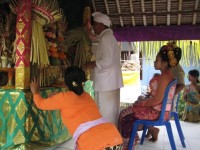 A short walk later, we arrived at an altar piled high with sweets and baskets of fruit. The bride and groom, who were seated in front of it, smiled at us warmly. Someone handed us plates of wedding cake and bottles of warm Coke. This is not how we would have treated tourists who barged into our wedding and started madly taking pictures. We were amazed at everyone’s hospitality and at our own good fortune.
A short walk later, we arrived at an altar piled high with sweets and baskets of fruit. The bride and groom, who were seated in front of it, smiled at us warmly. Someone handed us plates of wedding cake and bottles of warm Coke. This is not how we would have treated tourists who barged into our wedding and started madly taking pictures. We were amazed at everyone’s hospitality and at our own good fortune.